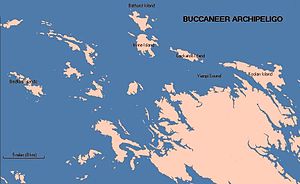Koolan Island

Koolan Island is an island off the Kimberley coast of Western Australia in the Buccaneer Archipelago. It is about 1,900 km (1,181 miles) north of Perth, and about 130 km (81 mi) north of Derby. It holds deposits of high-grade iron ore.
Description
The island is approximately 12 kilometres (7 mi) in length along an east–west axis and approximately 3 km (1.9 mi) at its widest point along a north–south axis. It encompasses an area of approximately 2,200 hectares (5,436 acres).[1] The island is only 1 km (0.62 mi) offshore, with a smaller island, Round Island, between Koolan and the mainland. Composed of Precambrian quartzite sandstone, the island has a rugged dissected terrain with jointed gorge forming narrowly valley drainage channels. The ridges have thin stony sandy soils. The highest point of the island is at 168 m (551 feet).[1]
BHP era
BHP commenced open-pit mining operations on Koolan and neighbouring Cockatoo Island in the late 1940s and by 1963 had established substantial mining operations there. The Koolan Island mine closed in 1994 after BHP had extracted 68 million tonnes of high-grade haematite ore, averaging 67% iron.
At its peak, Koolan Island had a population of 950 people and had a school, police station, recreation facilities and shops. It had the world's then-longest golf course hole — an 860 yards par 7 number 6 which doubled as the island's air strip.
Major rehabilitation of the island was undertaken since the mine closure, with buildings and exotic vegetation removed. Extensive replanting of native species has been undertaken.
Mine
When BHP ceased mining operations on the island in 1993 they flooded the Main Pit to the ocean by blasting part of the hanging wall. This has meant that the pit has been filled with approximately 10 billion litres of sea water, with a significant marine eco-system forming within the bounds of the former working pit. Due to the dense nature of the marine fauna within the Main Pit, Mount Gibson Iron plan to utilise numerous substantial blasts within the water filled pit in order to extract all marine creatures before dewatering operations are commenced. A Seawall will then be built around the ocean side of the pit in order to keep the ocean out. The pit will subsequently be dewatered in order to allow the rich ore reserves to be mined once again.
Earlier, in April 2006, the company signed a co-existence agreement with the Dambimangari (Dambima-Ngardi) indigenous Australian traditional owners of the island.[2] The agreement aims to ensure that 3% of the 220 person workforce is filled by indigenous people by the eighth year of operation.
A third island nearby, Irvine Island is also being considered for mining operations.
On 18 August 2006, Aztec announced that it had signed orders with the Chinese group CITIC for 1.5 million tonnes of ore from 2007.[3]
Aircraft crash
On 23 December 1984, a single-engined Cessna 210 aircraft, which had just taken off from the island en route to Broome, struck power lines and somersaulted. Six people were killed.
It appears the aircraft may have been overloaded with passengers and fuel at the time. The plane took off with the wind from the south across the strip rather than over the ocean and submarine rock. The gravel strip at the time had been affected by a cyclone in the area on the previous days.
Footnotes
- ^ a b Sue O'Connor (1989). "New radiocarbon dates from Koolan Island, West Kimberley WA". Australian Archeology. University of Queensland. Retrieved 10 August 2014.
- ^ Aztec Resources media release
- ^ "Iron ore supplier Aztec strikes deal with China". ABC News Online.
References
- A Job well done : the Koolan Island achievement. Perth, W.A. BHP Minerals, 1992. ISBN 0-86769-024-0
- Biological inventory of Koolan Island, Western Australia. Part 1. Flora and vegetation. in Records of the Western Australian Museum, Vol. 17, no. 3 (1995), p. 237-248
- Koolan Island - cave discovered containing (Pleistocene) Aboriginal archaeological material Iron ore chronicle, Vol. 234 (March 1989), p. 6.
External links
- Koolan Island transcript from George Negus Tonight 21 June 2004
- Credit Suisse investors report 11 March 2005
- Aztec Resources Commences Construction on Koolan Island Project from Yahoo Finance F 26 June 2006
